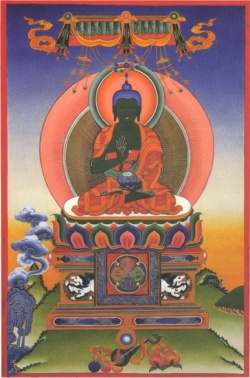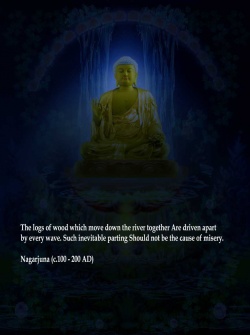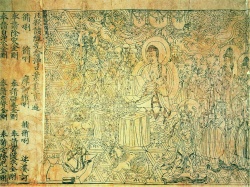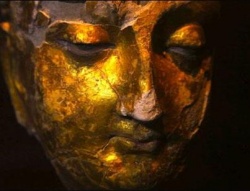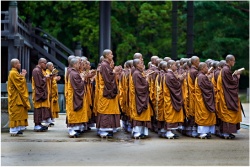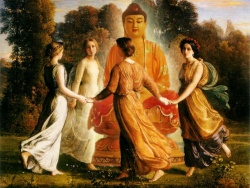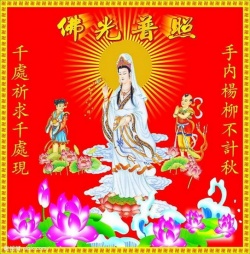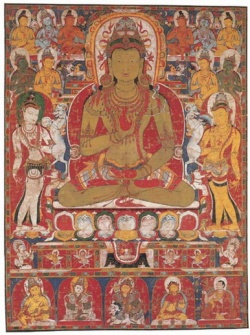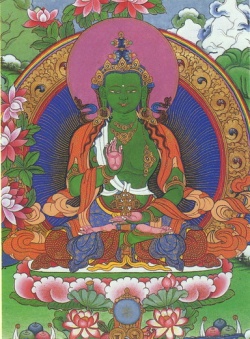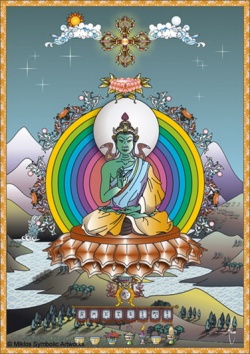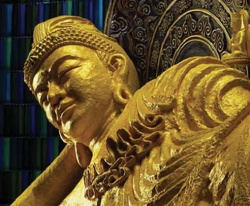Amoghasiddhi
Click here to see other articles relating to word Amoghasiddhi
Amoghasiddhi in other languages:
Chinese: 成就如來, Chengjiu Rulai
Japanese: 不空成就如来, Fukūjōju Nyorai
Tibetan: Dön yö drub pa Dön drub
Vietnamese: Bất Không Thành Tựu Như Lai
Amoghasiddhi is the last of the Five Dhyani or Five Wisdom Tathagatas. Amoghasiddhi Buddha (Bu-kong Cheng-jiu Fo): The green northern Buddha of Action with all-accomplishing wisdom.
One of the five transcendent buddhas. They are believed to have originated from Vajrasattva, the Buddha of purification.
Of these five, Amoghasiddhi is the buddha of the north.
He is associated with energy and known as the Lord of Karma and the Buddha of unfailing accomplishment.
His name literally means infallible (amogha) success (siddhi). He holds his hands in the Abhaya, fearlessness mudra.
Amoghasiddhi is the Buddha of all accomplishing wisdom.
He is venerated not only for his wisdom of success but he is also known to defeat envy.
As it says in Buddhist tradition, Devadatta, a very envious cousin of Amoghasiddhi once attempted to murder the Buddha by releasing a rampaging elephant into the Buddha's path to which Amoghasiddhi simply raised his mudra calming the beast, embodying both fearlessness and defeating envy.
He is often depicted as green and radiating green light as the color represents peace and tranquility of nature. The color is calming, it is soothing to anxiety.
When meditated upon, Amoghasiddhi is said to help relinquish envy, calm anxiety and fear and reveal wisdom of accomplishment.
Amoghasiddhi reverses the negative failing of envy into the positive wisdom of accomplishment.
Envy is a positive emotion as it feeds ambition and pushes us to reach higher. However, the bitterness generated towards the target of envy is a negative emotion.
When we can avert the associated bitterness and understand that the object of our envy is merely an agent leading us to greater Karma and better accomplishment, the message of Amoghasiddhi will be understood.
Amoghasiddhi (S): Tibetan: Donyo Drupa. Buddha of Unfailing Accomplishment; Lord of the Karma Family, the fifth of the Dhyani or Transcendental Buddhas that embody the five primordial wisdoms.
Lord of the Karma Buddha family, he is seated upon a lotus supported by shang-shang birds (S. garuda). Associated with the wisdom that achieves all, the transmutation of the poison jealousy, the color green, and the aggregate of volition, Amoghasiddhi is associated with the north of the ground of Prakuta Buddha, or Karmasampat, (T. la rab zog pa) "success in evolution."
His recognition symbol is the double dorje (visvavajra), representing the wisdom of all-accomplishing activity. His power and energy are both subtle, their dynamics often hidden from conscious awareness.
Amoghasiddhi is Lord of the Supreme Siddhi — the magic power of enlightenment which flowers in Buddha Activity.
In this way the inner and outer world, the visible and invisible are united as body is inspired and the great spirit of bodhicitta spontaneously embodies.
Amoghasiddhi is depicted with emerald-green skin, his left hand resting in his lap in the mudra of equipoise and his right hand at chest level facing outwards in the fearless (S. abhya mudra of granting protection.
He is often depicted in union with his wisdom consort Damtsig Drolma -- Green Tara, who embodies the pure element of air
Amoghasiddhi wields the crossed vajra or double dorje.
The consort of Amoghasiddhi is the Green Tara.
She is believed to have emanated from Amoghasiddhi and like him, she is a deity of action in the Buddhist pantheon.
Amoghasiddhi rides the half-man, half-eagle mix Garuda .
Garuda is associated with the Himalayas of the north, sharing a direction with Amoghasiddhi.
Garuda feeds on snakes and has an impeccable strength in vision to sense the serpent-like negative delusions that afflict our mortal frames.
Origin and Significance
Amoghasiddi holds his place in Buddhist cosmology as one of the five Dhyani Buddhas.
The Dhyani Buddhas are highly important to Mahayana Buddhism, each rich with an abundance of significant symbolism.
Specifically, each Dhyani Budda is the embodiment of a characteristic wisdom of the Buddha, and each is believed to be capable of overcoming a particular evil with a particular good.
The five also individualy represent one of the five skandhas:
(form,
consciousness,
feeling,
perception, and
mental formations).
As well, each is relevant as the representation of a wisdom, a direction, a color, a family, a poison, an action, a symbol, an element, a season and a mudra!
Additionally, each has their own consort, vehicle, and their own pure land.
As each buddha represents a family, they are often used as groupings for various tantras.
Given the broad range of characteristics embodied by the Dhyani Buddhas, their significance can be attached to an aspect of daily life, and there is a keen likelihood that any happenstance, feeling, sight, etc. will be associated with one of them.
These connection to the common make them well known and reverd among practitioners.
The specific origin of these Buddhas is a bit sketchy at times.
They are sometimes said to have "always been" and so their origin is only a matter of when they were cited in the writings.
There were at first only two, Aksobyha, and Amitabha (representing wisdom and comapssion respectively).
There was added Amoghasiddhi, Ratnasambhava, and Vairocana, who represented power, activity, and beauty.
Vairocana is regarded as the central figure in a cross shape configuration of the five,
with Amoghasiddhi heading the north, Aksobhya at the east, Ratnasambhava at the south and Amitabha at the west.
| Amoghasiddhi
(north) |
||
| Amitabha
(West) |
Vairocana | Akshobhya
(East) |
| Ratnasambhava
(South) |
Connected Cosmologies
Amoghasiddhi is one of the five Dhyani Buddhas.
The other four are:
Vairochana, representative of dharma itself, Akshobhya, representative of wisdom, Ratnasambhava, representative of the underlying sameness of all things, and Amitabha, representative of compassion.
Each of the Dhyani Buddhas is granted a distinct color as well.
This establishes Vairochana as the head of the Dhyani Buddhas, as his color white is the summation of the other four (red, blue, yellow, and green).
These five Buddhas serve as particular iconography for the historical Buddha's life, traits, and path to enlightenment. They also all serve to identify one negative emotion of motivation and transform it into a positive action.
Vairochana transforms ignorance, Akshobhya transforms attachment, Ratnasambhava transforms pride, Amitabha transforms anger, and Amoghasiddhi transforms jealousy.
Shedding these five traits and embracing only their positive aspects helps one on the path to enlightenment.
Amoghasiddhi is also commonly associated with the Green Tara as they both have strong connections to action.
Vairochana is the conqueror of ignorance and the leader of the five Dhyani Buddhas.
His color is white, as it is a blending of all the colors of the other Dhyani Buddhas.
Vairochana is typically depicted with the Dharmachakra mudra (Wheel of Dharma) to signify the teachings of the dharma and harkens to the Buddha's first sermon at Sarnath.
Akshobhya overthrows anger and attachment with the clarity of wisdom.
He is associated with the color blue, and is depicted in the earth-touching mudra.
This, of course, calls on the symbolic confrontation where the Buddha called on the earth as his witness to defeat Mara. Akshobhya is granted the east as his representative direction.
Ratnasambhava erodes pride with the understanding that all things are equal. He displays the Varada mudra to represent charity, which is why he is associated with the color yellow.
Ratnasambhava represents the Buddha's entire outlook onto humanity rather than a specific occurrence in his life – which is suiting considering it applies to all points equally.
His cardinal direction is the south.
Amitabha is depicted as red, for it is the color of compassion and love. Using these tools, Amitabha invalidates anger.
He's generally associated with the properties of the lotus (his emblem) for being gentle, open and pure.
Amitabha's hands are in the Dhyana mudra, meaning the mudra of meditation. His direction is the west.
Image Analysis
Typical Depiction
In a majority of the painted iconic images of Amoghasiddhi, he is shown with a green body, which can be seen as nature's peace and tranquility. The green color is meant to calm anxiety because of its soothing and relaxing nature.
To better understand the depth of meaning involved in Amoghasiddhi's portrayals. Amoghasiddhi is seated in his typical way (as described previously), with Manjushri on the right and Avalokiteshvara on the left.
The other ten beings in the painting are bodhisattvas. He sits on a throne that is supported on the outer edges by naga deities, seen by their serpent-like hoods.
The throne is also supported by kinnaras, or creatures who are half human and half bird (if in south-east Asia) or half human and half horse (if in India).
Abhaya Mudra
Amoghasiddhi is often depicted using the Abhaya mudra, or fearlessness gesture.
This mudra symbolizes peace, protection, and the dispelling of all fear, while also portraying an allaying of the senses.
With the presentation of the Abhaya mudra, it is said to convert all jealousy and envy into wisdom.
The mudra is meant to transform the delusion of jealousy into the wisdom of accomplishment.
As seen in the images presented below, Amoghasiddhi is presenting the Abhaya mudra with his right hand, and holding an object near his stomach in his left hand.
Double Vajra
Amoghasiddhi is holding the double vajra, a symbol of the consecutive conclusion of all actions.
This emblem that points in the cardinal directions represents that there is nothing in any direction that Amoghasiddhi cannot accomplish.
The double vajra is often carved in the base of Amoghasiddhi's statues, to symbolize the completion and consecration of the piece.
Source
Amoghasiddhi. (T. Don yod grub pa; C. Bukong Chengjiu rulai fo; J. Fukū Jōju nyoraibutsu; K. Pulgong Sŏngch’wi yŏrae pul 不空成就如來佛). In Sanskrit, “He Whose Accomplishments Are Not in Vain,” name of one of the Pañcatathāgata.
He is the [[buddha of the Karma] family]] (Karmakula) and his Pure Land is located in the north.
Amoghasiddhi is seldom worshipped individually and he appears to have been largely a creation to fill out the pañcatathāgata grouping.
He is usually depicted in the guise of a buddha, green in color, and sitting in Dhyānāsana with his right hand in Dhyānamudrā or with a viśvavajra in his upturned palm; his left hand is held at his chest in Abhayamudrā.
In Nepal, he alone of the five buddhas is shown with a Nāga above his face or coiled beside him.
In East Asian representations of the pañcatathāgata, Amoghasiddhi is often replaced with Śākyamuni Buddha.
Source
The Princeton Dictionary of Buddhism by Robert E. Buswell Jr. and Donald S. Lopez Jr.}
Amoghasiddhi The Lord of Karma (Tib. Donyo Drup pa): One of The Five Meditating Buddhas
The fifth Dhyani Buddha is Amoghasiddhi, whose distinctive emblem is the double dorje, also known as the crossed vajra.
The hand mudra made by Amoghasiddhi is the Abhaya mudra.
Abhaya in Sanskrit means fearlessness. Thus this mudra symbolizes protection, peace, and the dispelling of fear.
According to the Buddhist tradition, Buddha s cousin Devadatta felt greatly jealous of him.
His jealousy knowing no bounds, he once even attempted to murder the Buddha.
His plan involved loosing a rampaging elephant into the Buddhas path.
But as the elephant approached him, Buddha displayed the Abhaya mudra, which immediately calmed the animal.
Accordingly, it indicates not only the appeasement of the senses, but also the absence of fear.
Indeed, Amoghasiddhi s whole presence removes terror and fear.
His body is green, the color of the peace and tranquility of Nature.
It is a soothing and relaxing color, which calms anxiety. Amoghasiddhi rides on Garuda, the half man and half eagle composite, who feeds on snakes.
Blessed with a telescopic vision, Garuda can detect the presence of serpent like negative delusions plaguing our mortal frames even from a considerable distance.
Also, Garuda is associated with the Himalayan ranges of the north, which is the direction of Amoghasiddhi too. Amoghasiddhi is particularly associated with energy and is known as the Lord of Karma.
As a Buddha of action, he represents the practical achievement of results using the wisdom of the other four Buddhas.
His double vajra too is a symbol of the successive conclusion of all actions.
This is the reason why that after a deity statue has been completed and consecrated, a crossed vajra is inscribed upon the metal strip used to seal its base.
The goddess Green Tara is believed to have emanated from Amoghasiddhi and not surprisingly, she too is deified as a deity of action in the Buddhist pantheon.
Indeed, Green Tara is always depicted in a posture with her right leg extended, signifying her readiness to spring into action. Amoghasiddhi is believed to alter the negative human failing of jealousy into the positive wisdom of accomplishment.
Jealousy is a positive human emotion in as much that it fuels our ambition and prompts us to achieve greater heights. But its negativeness stems from the fact that it is almost always accompanied by a bitterness towards the one who is the target of our envy.
When we are able to ward off this associated feeling of resentment, and realize at the same time that the object of our jealousy is but a medium prompting us to greater karma, leading to higher accomplishments, we would have the read the message of Amoghasiddhi successfully.
One of the five celestial Buddha of the Mahayana Buddhism, Amoghasiddhi literally means the Unfailing success. He is shown in green colour with his left hand in his lap and his right hand making gesture of fearlessness.
North, green, karma family, envy and all-accomplishing wisdom.
One of the 5 Transcendent Buddhas;
Source
Amoghasiddhi (Skt.; Tib. དོན་ཡོད་གྲུབ་པ་, Dönyö Drubpa, Wyl. don yod grub pa; Eng. 'Accomplishing What Is Meaningful') — one of the buddhas of the five families.
He is the Buddha of the karma family, and is usually depicted as green in colour and holding a sword.
Source
Amoghasiddhi is one of the Five Wisdom Buddhas of the Vajrayana tradition of Buddhism. He is associated with the accomplishment of the Buddhist path and of the destruction of the poison of envy.
His name means He Whose Accomplishment Is Not In Vain.
His Shakti/consort is Tara, meaning Noble Deliverer or Noble Star and his mounts are garudas. He belongs to the family of Karma whose family symbol is the Double vajra/thunderbolt.
Characteristics
Amoghasiddhi is associated with the conceptual skandha or the conceptual mind (as opposed to the non-conceptual or sensational mind).
His action towards the promotion of Buddhist paths is the pacification of evils.
This is symbolized by Amoghasiddhi's symbol, the moon. He gestures in the mudra of fearlessness, symbolizing his and his devotees' fearlessness towards the poisons or delusions.
He is usually colored green in artwork and is associated with the air or wind element. His season is summer and his heavenly quarter, the north.
Source
Articles containing word "Amoghasiddhi" in title
- 2 Practices for Bonding with Amoghasiddhi
- A compendium of the initiation rituals of performance or all-accomplishing wisdom presided over by Amoghasiddhi
- Amoghasiddhi's
- Amoghasiddhi, Amogha-siddhi: 9 definitions - Wisdom Library
- Amoghasiddhi, Dhyani Buddha
- Amoghasiddhi, the Buddha of the Northern Pure Land late 11th century
- Amoghasiddhi/See Also Section
- Amoghasiddhi Buddha
- Amoghasiddhi Buddha - 2
- Amoghasiddhi Buddha - one of the Five Dhyani Buddha
- Amoghasiddhi Mantra
- Amoghasiddhi chakra
- Amoghasiddhi mantra and seed syllable
- Amoghasiddhi’s Wisdom
- Buddha Amoghasiddhi
- Buddha Amoghasiddhi Attended by Bodhisattvas
- Buddhist Deity: Amoghasiddhi
- Consort of Amoghasiddhi
- Foundations of Buddhism / Amoghasiddhi
- Introducing Amoghasiddhi
- Om Amoghasiddhi Ah!
- Puja to Amoghasiddhi
- Tathagata Buddhas by the artist Zanabazar (1635-1723): Ratnasambhava, Amitabha, Amoghasiddhi, Vairochana
- The Second Pledge of Buddha Amoghasiddhi is the General Pledge of Keeping all of the Aforestated Precepts of the Five Buddhas
- The Two Pledges Relating to the Buddha Amoghasiddhi
- What does quantum physics have to do with the Five Buddhas — Vairochana, Amitabha, Akshobya, Ratnasambhava, and Amoghasiddhi?
